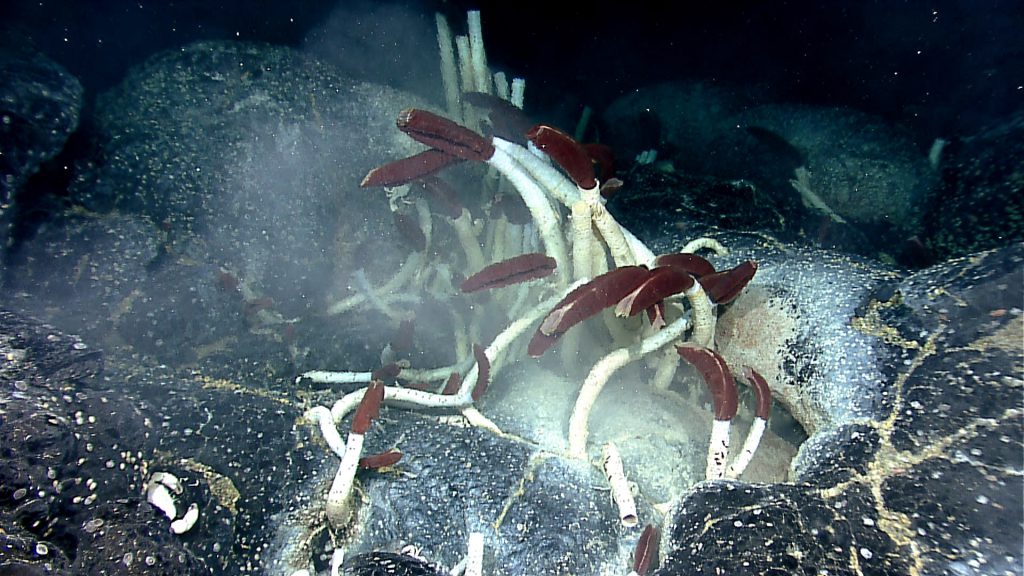Sunlight does not reach the deepest parts of the ocean, but life still thrives in the darkness. Below depths of 200 meters, where sunlight cannot reach, some organisms eat organic material that falls from the sunlit zone. For these organisms, photosynthetic organisms, such as phytoplankton and algae, form the basis of the food web. Other deep-sea organisms depend on a process called chemosynthesis, which is growth using energy from chemical reactions, rather than from the sun, as in photosynthesis.
Chemosynthesis is performed by many different types of microorganisms. Chemosynthetic microorganisms are primary producers, like plants, because they can use sources of energy that other organisms can’t use to form sugars, fats, and proteins that other organisms can consume. Groups of these microorganisms colonize seafloor deposits of certain minerals that they need to make sugars, fats, and proteins. These minerals, such as iron, manganese, cobalt, and sulfides, are also used by humans and are frequent targets of deep sea mining.
Scientists know that living systems perform ecosystem services, which are valuable, naturally occurring contributions to the functioning of the planet and the organisms that live here, including humans. The services provided by forests, such as trapping carbon as wood in tree trunks and releasing oxygen as a waste product during photosynthesis, are a well-understood example of ecosystem services. However, the ecosystem services provided by deep-sea chemosynthetic microorganisms are not well understood.
Recently, a group of scientists who wanted to better understand the value of the microbial ecosystems that inhabit seafloor mineral deposits held a workshop to assess the ecosystem services they provide. Among the topics discussed at the workshop, the scientists determined that deep-sea mining activities negatively impact some environments that host seafloor mineral deposits more severely than others. Specifically, they concluded that the microbial ecosystems inhabiting hydrothermal vent fields. Hydrothermal vent fields are like clusters of underwater chimneys that form in volcanically-active areas of the ocean floor. They perform unique ecosystem services that are interrupted by mining.
Hydrothermal vents spout hot, mineral-rich fluids into cold, oxygen-rich seawater. When the waters mix, extensive metal deposits can form on and just below the seafloor. As primary producers, chemosynthetic microorganisms that live in hydrothermal vent fields support diverse food webs. These food webs include rare animals that don’t exist anywhere else.
To survive in their harsh environment, vent microorganisms produce unusual molecules. Useful molecules produced by microorganisms in hydrothermal vents that have already been found include novel antibiotics, cancer treatments, enzymes used in biomedical research, and cosmetics. There are likely additional useful natural products produced by these microorganisms that have not yet been discovered and scientists believe that each individual vent site is host to some microbes that only occur at that vent site.
The microbial ecosystems found in hydrothermal vent fields are interesting research subjects in and of themselves. The first living cells may have formed in the dynamic environment of an ancient hydrothermal vent. Understanding the microorganisms that inhabit vents may help scientists understand how life on Earth began.
The scientists who attended the workshop had an important goal. They wanted to understand the impacts of deep-sea mining on microbial ecosystems so we can make informed decisions about how best to manage deep-sea mining projects. The authors say that the preservation of deep-sea microbial ecosystems is necessary for the survival of unique ocean animals and integral to many fields of research, including medicine and “origin of life” studies.


